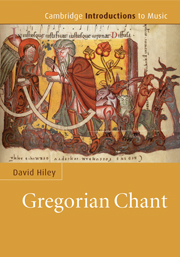Book contents
- Frontmatter
- Contents
- List of illustrations
- List of musical examples
- Note on the musical examples
- List of tables
- List of text boxes
- Preface
- Note on front cover illustration
- Chapter 1 Gregorian chant in the service of the church
- Chapter 2 The beginnings of Gregorian chant; other rites and other sorts of chant
- Chapter 3 Tradition and innovation in medieval chant: from the ninth to the sixteenth century
- Chapter 4 Thinking about Gregorian chant in the Middle Ages, and notating it
- Chapter 5 New chants for new times: from the sixteenth century to the present; aspects of performance
- Map of places from which important medieval chant manuscripts are preserved
- Chronological table
- Statistical table of chant categories by mode
- Original manuscript sources for musical examples
- Glossary
- Bibliography
- Index
Chapter 2 - The beginnings of Gregorian chant; other rites and other sorts of chant
Published online by Cambridge University Press: 05 October 2014
- Frontmatter
- Contents
- List of illustrations
- List of musical examples
- Note on the musical examples
- List of tables
- List of text boxes
- Preface
- Note on front cover illustration
- Chapter 1 Gregorian chant in the service of the church
- Chapter 2 The beginnings of Gregorian chant; other rites and other sorts of chant
- Chapter 3 Tradition and innovation in medieval chant: from the ninth to the sixteenth century
- Chapter 4 Thinking about Gregorian chant in the Middle Ages, and notating it
- Chapter 5 New chants for new times: from the sixteenth century to the present; aspects of performance
- Map of places from which important medieval chant manuscripts are preserved
- Chronological table
- Statistical table of chant categories by mode
- Original manuscript sources for musical examples
- Glossary
- Bibliography
- Index
Summary
Gregorian chant was established as the chant repertory of the Carolingian Empire, the dominant political power in the late eighth and ninth centuries, and this ensured its survival through the rest of the Middle Ages and, in various transformations, down to the present. Which is how Gregorian chant comes to occupy a central position in this book. But it was not the only sort of medieval chant. In the Latin West other chant repertories were sung for Latin rites independent of Rome. And in the Eastern Roman Empire yet others – the chant of the rites of Jerusalem, Antioch and Constantinople, the Georgian and Armenian rites, and various types of Slavonic chant – achieved a greater or lesser degree of fixity, enabling us to study them today. Even if they cannot be described in detail in this short book, their existence should be borne in mind as a parallel to the Gregorian chant repertory dominant in the West.
The Christian church in the late Roman Empire; Rome and the Franks
The early centuries
Gregorian chant is the musical element in a rich ritual, a ritual developed and performed by a stable religious community. Instability threatens or destroys the tradition, if things cannot be remembered and repeated year after year. The stable conditions in which chant could flourish were achieved in principle (if not everywhere in practice) after Christianity was recognized as one of the official religions of the Roman Empire under Constantine the Great (324–37).
- Type
- Chapter
- Information
- Gregorian Chant , pp. 83 - 120Publisher: Cambridge University PressPrint publication year: 2009



